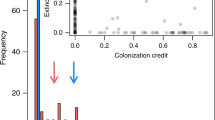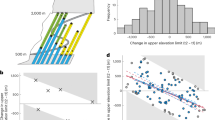Abstract
Quantitative estimates of the range loss of mountain plants under climate change have so far mostly relied on static geographical projections of species’ habitat shifts1,2,3. Here, we use a hybrid model4 that combines such projections with simulations of demography and seed dispersal to forecast the climate-driven spatio-temporal dynamics of 150 high-mountain plant species across the European Alps. This model predicts average range size reductions of 44–50% by the end of the twenty-first century, which is similar to projections from the most ‘optimistic’ static model (49%). However, the hybrid model also indicates that population dynamics will lag behind climatic trends and that an average of 40% of the range still occupied at the end of the twenty-first century will have become climatically unsuitable for the respective species, creating an extinction debt5,6. Alarmingly, species endemic to the Alps seem to face the highest range losses. These results caution against optimistic conclusions from moderate range size reductions observed during the twenty-first century as they are likely to belie more severe longer-term effects of climate warming on mountain plants.
This is a preview of subscription content, access via your institution
Access options
Subscribe to this journal
Receive 12 print issues and online access
$209.00 per year
only $17.42 per issue
Buy this article
- Purchase on Springer Link
- Instant access to full article PDF
Prices may be subject to local taxes which are calculated during checkout



Similar content being viewed by others
References
Thuiller, W., Lavorel, S., Araujo, M. B., Sykes, M. T. & Prentice, I. C. Climate change threats to plant diversity in Europe. Proc. Natl Acad. Sci. USA 102, 8245–8250 (2005).
Randin, C. F. et al. Climate change and plant distribution: local models predict high-elevation persistence. Glob. Change Biol. 15, 1557–1569 (2009).
Engler, R. et al. 21st century climate change threatens mountain flora unequally across Europe. Glob. Change Biol. 17, 2330–2341 (2011).
Thuiller, W. et al. Predicting global change impacts on plant species’ distributions: Future challenges. Perspect. Plant Ecol. 9, 137–152 (2008).
Tilman, D., May, R. M., Lehman, C. L. & Nowak, M. A. Habitat destruction and the extinction debt. Nature 371, 65–66 (2002).
Kuussaari, M. et al. Extinction debt: A challenge for biodiversity conservation. Trends Ecol. Evol. 24, 564–571 (2009).
Parmean, C. & Yohe, G. A globally coherent fingerprint of climate change impacts across natural systems. Nature 421, 37–42 (2003).
Chen, I-C., Hill, J. K., Ohlemüller, R., Roy, D. B. & Thomas, C. D. Rapid range shifts of species associated with high levels of climate warming. Science 333, 1024–1026 (2011).
Lenoir, J., Gegout, J. C., Marquet, P. A., De Ruffray, P. & Brisse, H. A significant upward shift in plant species optimum elevation during the 20th century. Science 320, 1768–1771 (2008).
Gottfried, M. et al. Continent wide response of mountain vegetation to climate change. Nature Clim. Change 2, 111–115 (2012).
Kelly, A. E. & Goulden, M. L. Rapid shifts in plant distribution with recent climate change. Proc. Natl Acad. Sci. USA 105, 11823–11826 (2008).
Bush, M. B., Silman, M. R. & Urrego, D. H. 48,000 years of climate and forest change in a biodiversity hot spot. Science 303, 827–829 (2004).
Tinner, W. & Kaltenrieder, P. Rapid responses of high-mountain vegetation to early Holocene environmental changes in the Swiss Alps. J. Ecol. 93, 936–947 (2005).
Colwell, R. K., Brehm, G., Cardelús, C. L., Gilman, A. C. & Longino, J. T. Global warming, elevational range shifts, and lowland biotic attrition in the wet tropics. Science 322, 258–261 (2008).
Pereira, H. M. et al. Scenarios for global biodiversity in the 21st century. Science 330, 1496–1501 (2010).
Guisan, A. & Thuiller, W. Predicting species distributions: Offering more than simple habitat models. Ecol. Lett. 8, 993–1009 (2005).
Eriksson, O. Functional roles of remnant plant populations in communities and ecosystems. Glob. Ecol. Biogeogr. 9, 443–449 (2000).
De Witte, L. & Stoecklin, J. Longevity of clonal plants: Why it matters and how to measure it. Ann. Bot. 106, 859–870 (2010).
Skov, F. & Svenning, J-C. Potential impact of climatic change on the distribution of forest herbs in Europe. Ecography 27, 366–380, 827–828 (2004).
Engler, R. et al. Predicting future distributions of mountain plants under climate change: Does dispersal capacity matter?. Ecography 32, 34–45 (2009).
Aeschimann, P., Lauber, K., Moser, D. M. & Theurillat, J. P. Flora Alpina Vol. 1–3 (Haupt Verlag, 2004).
Bradshaw, W. E. & Holzapfel, C. M. Evolutionary response to rapid climate change. Science 312, 1447–1448 (2006).
Brooker, R. W. Plant–plant interactions and environmental change. New Phytol. 171, 271–284 (2006).
Dullinger, S. et al. Postglacial migration lag restricts range filling of plants in the European Alps. Glob. Ecol. Biogeogr.http://dx.doi.org/10.1111/j.1466-8238.2011.00732.x (in the press).
Jackson, S. T. & Sax, D. F. Balancing biodiversity in a changing environment: Extinction debt, immigration credit and species turnover. Trends Ecol. Evol. 25, 153–160 (2010).
Schönswetter, P., Stehlik, I., Holderegger, R. & Tribsch, A. Molecular evidence for glacial refugia of mountain plants in the European Alps. Mol. Ecol. 14, 3547–3555 (2005).
Dirnböck, T., Essl, F. & Rabitsch, W. Disproportional risk for habitat loss of high-altitude endemic species under climate change. Glob. Change Biol. 17, 990–996 (2011).
Scherrer, D. & Körner, C. Topographically controlled thermal-habitat differentiation buffers alpine plant diversity against climate warming. J. Biogeogr. 38, 406–416 (2011).
Zimmermann, N. E. et al. Climatic extremes improve predictions of spatial patterns of tree species. Proc. Natl Acad. Sci. USA 106, 19723–19728 (2009).
Bullock, J. M. et al. Modelling spread of British wind-dispersed plants under future wind speeds in a changing climate. J. Ecol. 100, 104–115 (2012).
Acknowledgements
This research was financially supported by the EU 6th Framework Programme for Research, Technological Development and Demonstration (project ECOCHANGE, GOCE-CT-2007-036866) as well as by the Danish Council for Independent Research—Natural Sciences (grant 272-07-0242 to J-C.S.) and the ANR Diversitalp project (ANR-2007-BDIV-014). We thank the Vienna Scientific Cluster (http://vsc.ac.at/) for granting access to its computational resources. Niche-based models were performed using the CIMENT infrastructure (https://ciment.ujf-grenoble.fr), supported by the Rhône-Alpes region (GRANT CPER07-13 CIRA). Thanks to S. Rechnitzer for improving the English.
Author information
Authors and Affiliations
Contributions
S.D., W.T., N.E.Z., A. Guisan and K.H. designed the study. N.E.Z., A.P. and D.R.S. processed the climatic data, and W.W. prepared the soil map. S.D., W.T., N.E.Z., A. Guisan, W.W., M.C., T.D., A.F., J.L., J-C.S., U.S. and P.V. contributed vegetation plot data. W.W. and J.L. compiled the plot database. W.T. calibrated and fitted all niche-based models. S.E., S.D. and K.H. collected plant seeds and S.E. measured seed traits. T.M. and M.L. implemented dispersal models and S.D. calibrated dispersal kernels. S.D., A. Gattringer, K.H. and M.L. designed the hybrid model, A. Gattringer translated it into C code and ran the code on the Vienna Scientific Cluster. K.H. and S.D. analysed the simulation results. D.M. and C.P. did all geographic information system work. S.D. wrote the paper, with substantial help from all co-authors.
Corresponding author
Ethics declarations
Competing interests
The authors declare no competing financial interests.
Supplementary information
Rights and permissions
About this article
Cite this article
Dullinger, S., Gattringer, A., Thuiller, W. et al. Extinction debt of high-mountain plants under twenty-first-century climate change. Nature Clim Change 2, 619–622 (2012). https://doi.org/10.1038/nclimate1514
Received:
Accepted:
Published:
Issue Date:
DOI: https://doi.org/10.1038/nclimate1514
This article is cited by
-
Extinction drives recent thermophilization but does not trigger homogenization in forest understorey
Nature Ecology & Evolution (2024)
-
Integrating field- and remote sensing data to perceive species heterogeneity across a climate gradient
Scientific Reports (2024)
-
Transnational conservation to anticipate future plant shifts in Europe
Nature Ecology & Evolution (2024)
-
Anthropogenic climate and land-use change drive short- and long-term biodiversity shifts across taxa
Nature Ecology & Evolution (2024)
-
Responses of photosynthesis and chlorophyll fluorescence during light induction in different seedling ages of Mahonia oiwakensis
Botanical Studies (2023)



